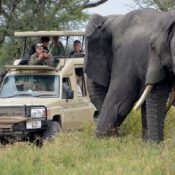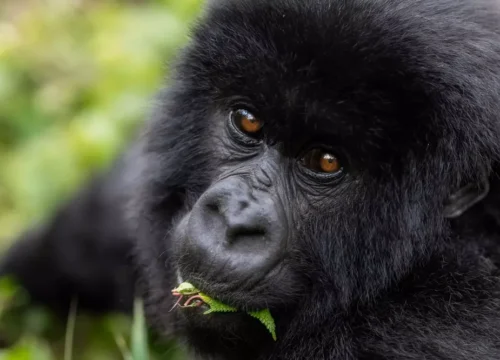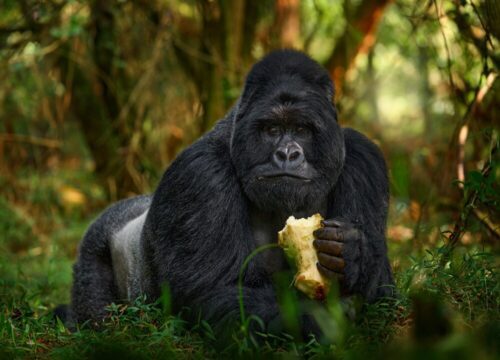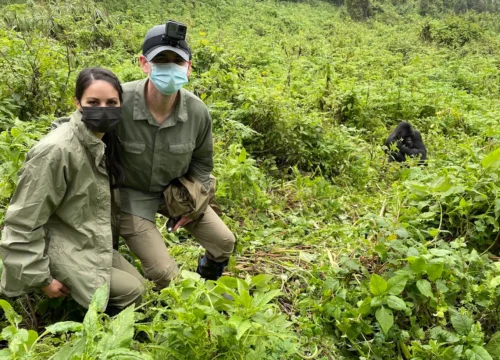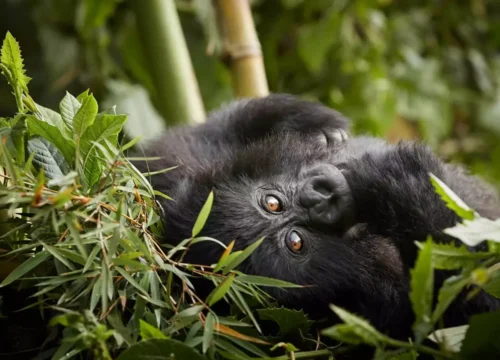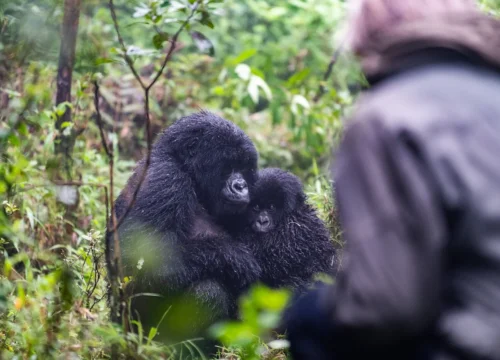Sabi Sand Nature Reserve
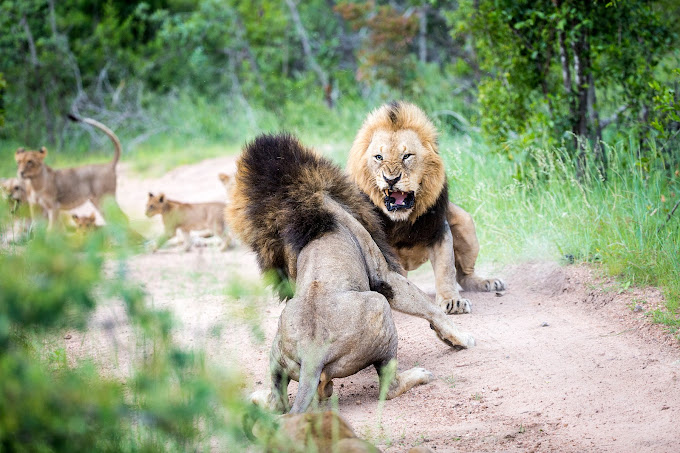
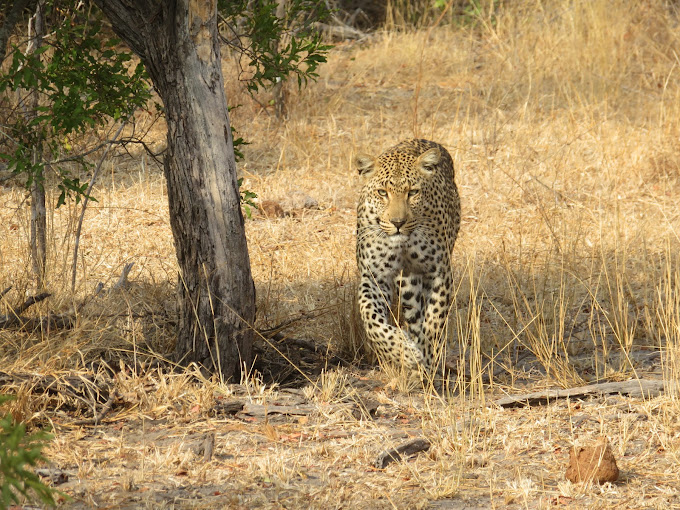
Sabi Sand Nature Reserve Overview
Sabi Sand Nature Reserve shares a 50km/30mi unfenced border with Kruger National Park and offers the best wildlife viewing in South Africa. The area is divided into individual private game reserves, all offering the ultimate Big Five experience, luxury accommodation, great service and excellent food.
Sabi Sand Nature Reserve Pros & Cons
- Superb wildlife viewing with good sightings of the Big Five
- Good guides and trackers take you out on two drives a day
- Off-road driving allows close viewing of animals
- Excellent high-end luxury safari lodges
- Mostly expensive, fully-inclusive safari packages available
- Emphasis on Big Five animals and ticking off flagship species
Wildlife in Sabi Sand Nature Reserve

Sabi Sand Nature Reserve is the place in South Africa to easily see all of the Big Five in a short period. Even a two-day visit is usually enough to see all flagship species. With a good population of highly habituated leopards, Sabi Sands is one of the best places in Africa to see these normally elusive cats. Lion and cheetah are also easily seen.
Scenery
Sabi Sand Nature Reserve is an extension of Kruger National Park and has the same relatively thick vegetation consisting of woodland savannah. Two rivers run through the reserve, providing water. The riverine vegetation makes an excellent habitat for leopard and other wildlife.
How to Decide Where to Stay
Most places within Sabi Sand Nature Reserve offer the same deal: upmarket safari packages, including accommodation, all meals and activities. Some upmarket lodges include drinks while others don’t. The individual reserves share fenceless borders with the Greater Kruger ecosystem and offer a comparable wildlife viewing experience. All Sabi Sands reserves are excellent safari destinations. When deciding where to stay, the differences in the following factors could be taken into account:
- Property size and traversing rights
Traversing rights mean that the guests of one reserve are allowed to enter the property of another reserve on game drives. While traversing rights give people access to a greater area, it also means that areas shared by multiple reserves often get more crowded. This can create congestion and time pressure around wildlife sightings since only three vehicles are allowed at any particular sighting. The best deal is a large property with limited or no traversing rights. Singita and Londolozi, for example, have a large property without traversing rights. The same applies for MalaMala, which used to be part of Sabi Sands, but now operates as an independent reserve. - Luxury level and rates
Although all offer luxury and expensive options, there are some differences. Londolozi and Singita are, for example, more expensive and very luxurious. The unpretentious Umukumbe Safari Lodge is a lot more affordable. Elephant plains has a range of accommodations including well priced rondavels. - Access to river frontage
River frontage is a plus because it attracts animals. While waterholes have the same effect, a river is also a scenic feature, and it provides an opportunity to see elephants in the water. Some of the reserves have no river frontage but have traversing rights onto a property that does, which amounts to the same thing.
The properties and river can be seen on this map.
Places to Stay in Sabi Sand Nature Reserve
- Arathusa
Star rating: 4; family owned/managed, well-priced small property on large traversing block, no access to river frontage.
www.arathusa.co.za - Cheetah Plains
Moderately priced (in comparison), small property on large traversing block, but only limited traversing allowed, no access to river frontage.
www.cheetahplains.com - Chitwa Chitwa
Moderately priced (in comparison), small property on large traversing block, no access to river frontage.
www.chitwa.co.za - Dulini
Three luxury lodges with river frontage on a medium-sized property on large traversing block with river frontage. - Elephant Plains
Star rating: 4; well priced, small property on large traversing block, no access to river frontage.
www.elephantplains.co.za - Idube
Star Rating: 4; small property on large traversing block, access to river frontage. - Inyati
Medium-sized property on large traversing block, owns river frontage. - Kirkman’s Kamp
Part of the excellent & Beyond group; moderately priced (in comparison), & Beyond lodge, large property with extra traversing rights on MalaMala, owns river frontage.
www.andbeyond.com - Leopard Hills
Very expensive, small property on big traversing block, access to river frontage.
www.leopardhills.com - Lion Sands
River Lodge: 5 Star; moderately priced (in comparison), Ivory Lodge: 6 Star; very expensive, large property without any traversing rights, very exclusive with wide river frontage. - Londolozi
Very expensive and luxurious, large property without any traversing rights, very exclusive with river frontage. - MalaMala Game Reserve
Unpretentious, moderately priced to very expensive. Independent from Sabi Sands but neighboring the same area without fences. By far the biggest property in the Sabi Sands area, with the most extended river access. Very limited traversing rights with one property far away from MalaMala’s usual wildlife viewing area. - Nkorho
Star rating: 4; well-priced, small property sharing traversing with two other small properties, no access to river frontage.
www.nkorho.com - Nottens
Unpretentious, owner-managed, authentic bush experience, well-priced, medium-sized property, no traversing, lodge overlooks the Sand River.
www.nottens.com - Sabi Sabi
Very expensive except for Little Bush Camp which is moderately priced (in comparison), large property with limited traversing to one small property, very limited river frontage access. - Savanna
Star rating: 5; Moderately priced (in comparison), medium-sized property on big traversing block, river frontage access.
www.savannalodge.com - Singita
Very expensive and luxurious, large property without any traversing rights, very exclusive with river frontage. - Ulusaba
Star Rating: 5; very expensive, medium sized property on big traversing block, river frontage access. - Umkumbwe
Unpretentious, owner-managed, well-priced, medium-sized property, no traversing, lodge overlooks the river.
www.umkumbe.co.za
Weather & Climate in Sabi Sand Nature Reserve
Winter in Sabi Sand Nature Reserve (May to September) is when the landscape dries out due to lack of rain. The temperatures are agreeable during the day, but it gets cold when the sun is below the horizon – put on plenty of warm clothes for early or late game drives. The summer months (October to April) bring afternoon thunderstorms and soaring temperatures.
Best Time To Visit Sabi Sand Nature Reserve

Sabi Sand Nature Reserve can be visited throughout the year and wildlife viewing is good at any time. There is a slight advantage in the dry winter months (May to September) when animals congregate around the rivers and the bush thins out. The summer months (October to April) see some rain and it tends to be very hot and humid during the day. But the scenery is lush at this time and evenings and early mornings are pleasantly mild.
Wildlife & Animals in Sabi Sand Nature Reserve
Sabi Sand Nature Reserve offers excellent wildlife viewing. This is especially true of the big cats. All of the Big Five are usually seen in a two to three-day visit. Off-road driving assures quality sightings, particularly of the habituated resident predators. Sabi Sand is part of the vast Greater Kruger ecosystem, which makes for a very authentic wildlife experience.
Wildlife Highlights in Sabi Sand Nature Reserve
Sabi Sand Nature Reserve is possibly the best place in Africa to see leopard. Both the quantity and quality of sightings is superb. This is a place where you can see leopard behavior such as males marking and patrolling their territory or females interacting with their cubs. Wild dog sightings are less common, but if they are denning in the area, it is often possible to spend time with these social pack animals.
Best Time for Wildlife Viewing in Sabi Sand Nature Reserve
Wildlife viewing in Sabi Sand Nature Reserve is very good throughout the year but perhaps at its best during the Dry season (June to September). August and September are particularly nice since it is warmer than in mid-winter and animals tend to gather at water sources, making them easier to spot.
Birds in Sabi Sand Nature Reserve

With more than 300 bird species on its list, Sabi Sand Nature Reserve is a great birding destination. Guides tend to be very knowledgeable about birds and everything else. The combination of walking and driving safaris in the private reserves is also very suitable to birding. The emphasis invSabi Sand Nature Reserve is, however, on mammals and the Big Five. It would be advisable to book private game drives if you are a birder. Migratory birds are present from November to April.
Birding Specials in Sabi Sand Nature Reserve–Treats for Avid Birders
- African black duck
- African crake
- African emerald cuckoo
- African finfoot
- African hawk-eagle
- Black-crowned night heron
- Coqui francolin
- Croaking cisticola
- Dwarf bittern
- Eastern black-headed oriole
- Gabar goshawk
- Grey cuckoo-shrike
- Half-collared kingfisher
- Mosque swallow
- Purple heron
- Senegal lapwing
- Shelley’s francolin
- Shikra
- Thick-billed cuckoo
- Verreaux’s eagle owl
- White-backed night heron
Best Time for Bird Watching
Bird watching is good year-round in Sabi Sand Nature Reserve, although at its best from November to April when the migratory birds from the northern hemisphere are present. Wildlife viewing, in general, is best when the climate is dry – during the months of June through September.
Best Time To Visit Sabi Sand Nature Reserve
The best time to visit Sabi Sand Nature Reserve is during winter, which is also considered the ‘low season’. This is the Dry season which lasts from May to September. Animals are easy to spot during the dry months as foliage becomes less abundant and they gather around rivers and waterholes. September is a lovely month to visit. It is also the least cold of the winter months.
May to September –Dry Season – Winter
- Animals are easier to spot as they concentrate around water sources
- It is low season
- Virtually no rain and lots of sunshine
- Mild daytime temperatures and low humidity
- Very little risk of malaria
- The air is dusty and dry
- It is necessary to wear warm clothing for morning and evening game drives
October to April –Wet Season – Summer
- The scenery is lush and green
- There are many newborn animals around
- Birding is excellent, and migratory birds are present
- The Dry season is the best time for wildlife viewing
- It can be crowded since it is high season
- Days are hot and humid
- Antimalarial drugs are necessary
Weather & Climate
Sabi Sand Nature Reserve experiences winter and summer at opposite times to those seasons in Europe and North America. October to April are the hot, wet summer months while the mild, dry winter occurs from May to September. Although winter days are pleasant, it is cold in the mornings, so warm clothes are advisable for game drives.
Dry Season–May to September – Winter
For the most part, it doesn’t rain during the winter and humidity is low. Permanent water sources become a place for animals to gather, making them easier to spot.
- May – May marks the end of summer. Temperatures are around 11°C/52°F in the morning and 28°C/82°F in the afternoon as the weather cools.
- June, July & August – Due to the cold mornings (10°C/50°F), it is wise to bring along warm clothing for morning game drives. There will be cloudless skies in the afternoon and temperatures will be pleasant at around 24°C/75°F.
- September – The first rains bring relief and alleviate the dry conditions. The heat rises to an average afternoon temperature of 27°C/81°F. Mornings are mild with average temperatures around 15°C/59°F.
Wet Season–October to April – Summer
Summer can be hot and humid, sometimes to an uncomfortable level. Temperatures often reach 40°C/104°F, but the daytime average is around 32°C/90°F with high humidity. Afternoon storms are normal, yet all-day rainfall is rare.
- October & November – Temperatures increase and afternoon rains become more frequent. Typical temperatures range from 18°C/64°F in the morning to 30°C/86°F in the afternoon.
- December, January & February – These months have the most rainfall and highest temperatures, coupled with intense humidity. The average afternoon temperature is 33°C/91°F, but it is not unusual for it to reach an unbearable 40°C/104°F.
- March & April – The rain decreases, and it gradually cools. This trend continues into April, which is the most pleasant month with little rain, less humidity and sunny skies. Nighttime temperatures fall to 15°C/59°F and daytime temperatures of 32°C/90°F are typical.
Getting There
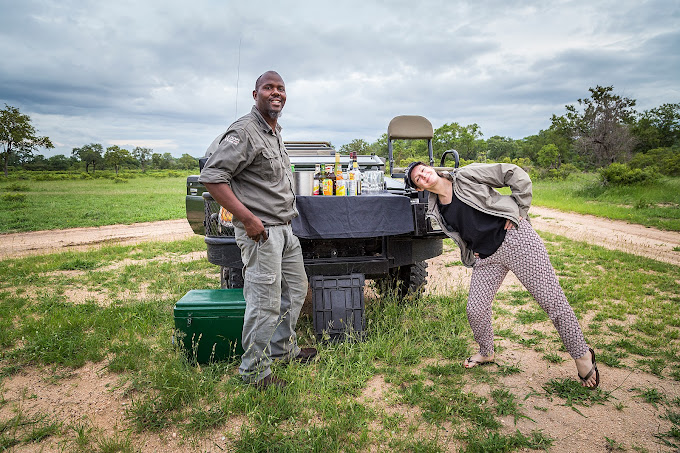
Coming from abroad, you’ll arrive at O.R. Tambo International Airport (JNB) in Johannesburg. From there, you can take the twice-daily scheduled flight to Sabi Sand Nature Reserve, run by Federal Airlines.
It is also possible to fly directly from Germany or to take a connecting flight from Johannesburg to Kruger Mpumalanga International Airport (MQP), near Mbombela. Alternatively, you can take a connecting flight from Johannesburg to Skukuza Airport (SZK) in Kruger National Park. A transfer from Mbombela or Skukuza to your Sabi Sand Nature Reserve accommodation can be arranged and takes about 2 hours.
It is also possible to hire a car in Johannesburg and drive to the park via the N4 to Mbombela. The reserve has three entrance gates for access to different lodges. The distance is about 500km/310mi, and the drive takes about 5½ hours*.
Malaria & Safety in Sabi Sand Nature Reserve
Safety
Travel within most parks and reserves in South Africa can be done safely in our opinion, as is the case with Sabi Sand. It is recommended to take normal safety precautions when visiting cities in South Africa. Also read ‘Cities & Urban Areas: Safety Precautions’ below for more information. When following these precautions, you’re very unlikely to have any incidents with crime on your trip.
Malaria & Vaccinations
As malaria is present in Sabi Sand Nature Reserve, the wet summer months pose a very slight risk of catching malaria. If you are visiting at this time, measures you can take to protect yourself include using mosquito repellent containing DEET and taking antimalarials. Travel to South Africa, including Sabi Sand, might require several vaccinations. Consult your doctor for details.
INQUIRE NOW
GENERAL INFORMATION ON A SOUTH AFRICA SAFARI
ENTRY REQUIREMENTS:
All visitors to South Africa must have a valid passport with at least 4 consecutive blanks pages. Any applicable visa and/or relevant documentation are the responsibility of the traveller. For further information on Visa requirements visitors are advised to contact their nearest South African Embassy or Consulate.
LANGUAGE:English
TIME: GMT +3
VOLTAGE: 220 Volts/AC50Hz. Sockets are UK style, 3 pin square plugs. Power is from the government in the city/major towns and generator with inverter back up in the Safari Lodges and Camps.
CURRENCY: Foreign currency must be changed at the Bank, Bureau de Change, and Hotel/Safari lodge/Camp/Resort. Major Credit Cards, Master card, Visa, American Express, are usually accepted throughout the country. Where credit cards are accepted, the payment will normally be recorded in US$ regardless of the card’s default currency.
CLOTHING: Dress is mainly informal and should be comfortable as well as practical. Something warm should be brought along for early morning and evenings. Safari clothes are available from hotels/lodges/camps.
BAGGAGE: Where possible, travel light. Baggage space on safari is limited to medium suitcase or soft bag per person plus reasonable amount of hand luggage. There is 15 Kilogram per person limit on all flights to the wildlife sanctuaries. Excess luggage must be stored in your arrival hotel.
WATER: You will find many different of opinion of what is safe and what is not. We recommend for peace of mind, to drink local Bottled Mineral water. It is important to drink plenty of water especially during the hotter months. We would recommend that guests drink at least 2 to 3 liters of water per day to limit the effects of dehydration.
HEALTH; East Africa is a safe and secure destination; however, it is a good idea to take a few precautions. Kindly consult your GP or local doctor at least 6 weeks before you travel, with regards: Malaria prophylactics. East Africa is a known malaria area and preventive measures are essential. You are advised to take one of the recommended anti-malarial drugs. Be sure to wear long sleeved shorts and trousers after sunset and spray the exposed parts of your body with a mosquito repellent spray Remember to protect yourself from direct sun rays with sunscreen cream or safari hat.
DIETARY REQUIREMENTS: For those guests with specific dietary requirement, please ensure we are notified prior to travel
GRATUITIES: As a guideline and dependent on how happy you are, we would suggest the following: The General Hotel/Lodge/Camp Staff – Approximately U$ 10.00 per person per day Driver Guides – Approximately US$ 15.00 to US$ 20.00 per person per day.
PHOTOGRAPHY: Please be careful when photographing public buildings, airports, bridges, the national flag and people in uniform. Ensure that you have sought permission before photographing local people and their villages. If in doubt, please check with your guide.
Book a Customized Safari
Read about
10 Things you Should NOT DO on an African Safari.
What to expect on a safari in Uganda.
Bwindi Impenetrable National Park
How to Choose the Best Tour Operate for Your Safari in Africa
12-Day Gorilla Tracking in Bwindi
Some of our Gorilla and wildlife Safaris
1 Day Jinja Ultimate tour Experience
1 Day White Water Rafting in Jinja
3 Days Bwindi Gorilla Habituation via Rwanda
3 Day Birding Safaris and Photography in Uganda
3 Day Safari to Queen Elizabeth National Park
3 Day fly in Gorilla Trekking Safari from Masai Mara
3 Day Grand Gorilla Trekking Safari
4 Day Chimpanzee and Gorilla Trekking Safari
Recent Posts
Last Minute Deals
Quick booking process
+49 1575 4711313



